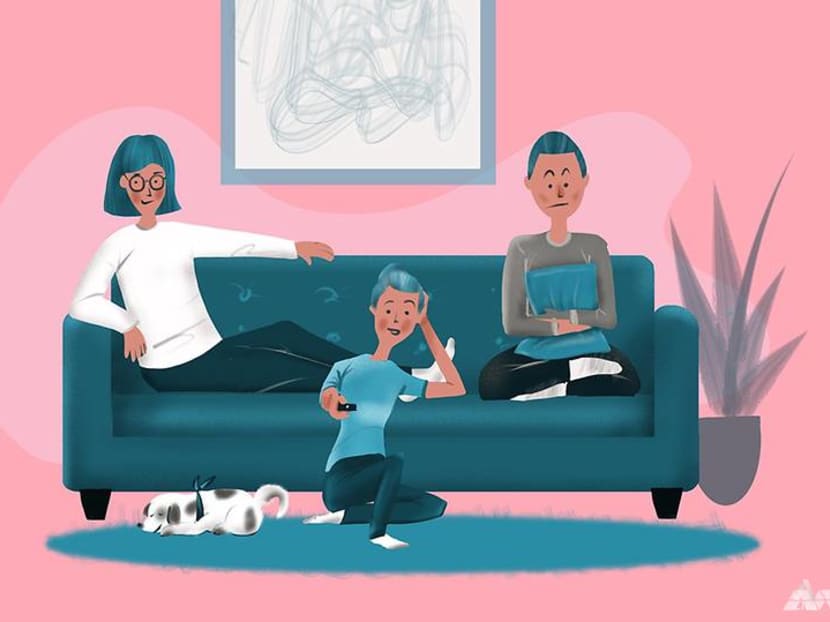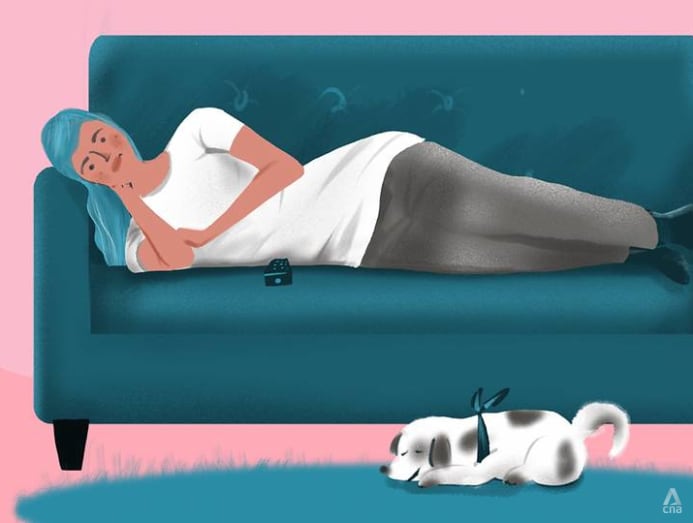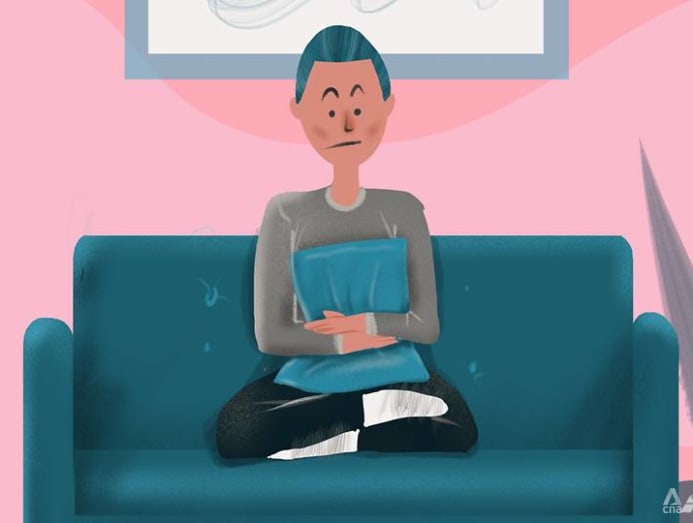Is binge-watching giving you a backache? Here’s how to prevent it
Advertizing
Wellness
Is binge-watching giving you a backache? Here'due south how to prevent it
Who knew Idiot box bingeing could be dorsum-breaking work? CNA Lifestyle spoke to the experts on how your favourite Goggle box-watching position tin hurt your back, neck and shoulders.

(Art: Jasper Loh)
21 Mar 2022 06:06AM (Updated: 10 Aug 2022 12:45PM)
With more than people working from domicile or practising self-isolation and social distancing, TV bingeing is becoming a common activity these days.
You select the channel, settle downwards on the sofa and before you know information technology, it's already night (wasn't there daylight when you started?). As for your dorsum and cervix, they feel as potent as the zombies in the mean solar day in Kingdom, the S Korean drama series you just finished doing a marathon on.
READ: six stretches to relieve muscle tension in the office
Sounds familiar? That's because stiffness and pain of the neck, upper back and lower back are the common issues that people face when Television receiver bingeing, said Rachelle Lim, a principal physiotherapist with Changi General Infirmary's Rehabilitative Services.
After all, no one sits with a ramrod straight back – or not for long – when watching TV. You lot tend to slide down the seat of the sofa and lean your upper back confronting the backrest, said Sylvia Ho, a senior main physiotherapist from Core Concepts.
"In such a position, the lower dorsum muscles and joints become stretched, which can cause pain to develop." This slouching position too creates the forward head posture, which "increases tension in the neck muscles, causing them to tighten and the joints to stiffen in the long term", she said.
READ: Sitting for long periods may sabotage the benefits of exercise
That's non all. Some people also similar to sit with i leg crossed over the other, which creates an uneven weight distribution on the pelvis, said Esther Lan, a chief musculoskeletal physiotherapist with Physio And Sole Clinic. Twisting your torso can also cause muscle imbalance at each side of the spine, she said.
HOW TO MINIMISE TV BINGEING-INDUCED ACHES AND Hurting
The best thing yous can do for your body is to minimise sitting in one position for too long, said Fred Chen, another principal musculoskeletal physiotherapist from Physio And Sole Clinic. "Move is lotion, then movement is the best manner to prevent pain from setting in."
The good news: Y'all don't have to do sit-ups or push-ups while watching the goggle box. "Getting up and moving every xx to 30 minutes tin can reduce accumulative strain on the back," said Lim, who suggested "neck, arm and leg movements, hand squeezes, marching on the spot and mini squats".
"Such breaks are also associated with beneficial metabolic effects, which can lead to decreased waist circumference, body mass index, and body fat," she said. Translated: Yous can beat the burl on the couch.
READ: Standing more than, sitting less at work to lose weight? Don't get your hopes up
But if you find information technology disruptive to break an exhilarating one-hr episode midway through, Ho said that "taking a five-to-10-minute break after 50 to hour of sitting down is meliorate than taking a 20-infinitesimal pause every iii hours". Small, frequent breaks are better than long only infrequent ones, she said.
Here'south a await at the common (and cheekily named) postures you might consciously or unconsciously slide into when watching Television receiver, what damage they tin cause and how to save yourself from a bunch of aches and hurting. Who knew TV watching could exist so dorsum breaking?
THE Classic SLOUCH

The "ow" you feel in your lower back from this position is caused past the poor support in that area, said Lim. "(The minimal lower dorsum back up) can lead to pain, achiness and stiffness of dorsum, buttocks and even down the legs."
Propping your feet upwardly on the coffee tabular array with straightened knees isn't doing yous any favours either, said Ho. The posture increases the stretch on the sciatic nerve and those with lower back weather condition may experience aggravated pains in the dorsum and leg, she said. "Placing both feet on the flooring, or ensuring that the knees are slightly aptitude when elevating the legs are recommended approaches."
You've probably heard this before but sit up and sit down back – and lean into the back of the couch, said Lim. This is to ensure your buttocks and lower dorsum are well supported. "Yous can also prop your lower dorsum with a cushion, or move the coffee table closer to the couch for leg support," she added.
THE MULTI-TASKING TWIST

"This could be someone using the laptop while watching telly," said Lan. "In this sitting position, the spine tends to slouch as both legs are stretched out for long. This is especially pronounced for people with tight hamstring muscles." Furthermore, she added, your body weight is not evenly distributed through the pelvis and spine – and this tin can cause lower back and/or tailbone discomfort.
It gets worse when information technology comes to your neck, said Chen. Without the back up of a head residual, you'll tend to support the weight of your head with a forwards caput posture. This can atomic number 82 to neck strain and upper back stiffness. "This is especially so if you practice non accept enough core forcefulness to continue y'all up in this position," said Chen.
SIDEWAY Activity

Depending on the tiptop of your armrest, your cervix might be in an bad-mannered position, said Lan. "The armrest may non have the adequate support for your cervix and might cause neck articulation, muscle and ligament strain resulting in neck anguish, headache or arm symptoms."
Instead of using the armrest for caput support, apply a pillow or cushion that allows your neck to be in a neutral position as much as possible, said Lan.
If this is one of your favoured positions, Lim suggested alternating lying on your left and right sides, preferably with the cervix and shoulder comfortably supported.
THE LEG DRAPE

Lying down with 1 leg flung over the sofa for prolonged periods might create back strain or hip discomfort as the pelvis is tilted to 1 side, said Lan.
"Avoid this position if possible." Ho agreed. "This position volition cause the mid-lower back to be in a rotated position," she said. "It is a discouraged position to be in to watch television."
Not that you tin't exist lying downward when watching TV. "Use a pillow or absorber that allows your neck to be aligned in as close to the neutral position as possible," said Lan.
BUDDHA HUGS THE Cushion

"Sitting in a cross-legged position causes us to lean our body forward," said Lim. If you savor hugging a absorber while sitting cross-legged, especially when streaming a horror movie, make sure y'all sit back into the couch so that your buttocks and lower back are well supported, said Lim. "It may too be helpful to alternate into other positions periodically, or straighten the legs to relieve any pressure level," she said.
Or try placing a cushion at the pocket-size of your back to encourage a more neutral spine position, advised Chen.
YOU'VE GOT YOUR BACK (NOT)

Chances are, you'll end up tilting your caput to one side, said Lim, and potentially straining your neck and shoulders. "This can lead to hurting, achiness and stiffness of the neck, shoulder and even down the arms," she said. To stay comfortable, regularly alternating leaning your head to the left and right, or keep your head and cervix upright, she said.
"Also, prolonged sitting on the floor tin be challenging on the knees and hips when getting up," said Lim.
Contempo Searches
Trending Topics
Source: https://cnalifestyle.channelnewsasia.com/wellness/how-to-prevent-backaches-while-watching-tv-237006

0 Response to "Is binge-watching giving you a backache? Here’s how to prevent it"
ارسال یک نظر